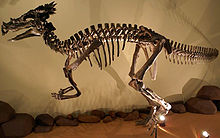Dracorex
| Dracorex | ||||||||||||
|---|---|---|---|---|---|---|---|---|---|---|---|---|

Skull of Dracorex |
||||||||||||
| Temporal occurrence | ||||||||||||
| Upper Cretaceous (late Maastrichtian ) | ||||||||||||
| approx. 67 to 66 million years | ||||||||||||
| Locations | ||||||||||||
| Systematics | ||||||||||||
|
||||||||||||
| Scientific name | ||||||||||||
| Dracorex | ||||||||||||
| Bakker et al., 2006 | ||||||||||||
| Art | ||||||||||||
|
Dracorex ( lat. "Dragon King") is a genus of Pachycephalosauria , a group of dinosaurs belongingto the bird basin dinosaurs from the late Upper Cretaceous (late Maastrichtian ) of North America. The only scientifically described species , and thus type species , is D. hogwartsia . Like all pachycephalosaurs, Dracorex was a two-legged herbivorous animal.
Find history
Dracorex hogwartsia has so far only been documented by a fossil find, which mainly consists of an almost complete fossilized skull with teeth. In 2003, three fossil collectors recovered the heavily crumbled remains from the rock of the Hell Creek Formation, known for its wealth of fossils, from the Upper Maastrichtium in the US state of South Dakota . They also found four associated cervical vertebrae : the first cervical vertebra C1 or atlas when viewed from the head , the C4, C8 and C9. The following year, the finders handed the fossils over to the Children's Museum of Indianapolis , the largest children's museum in the world. The vertebrate palaeontologist Victor Porter, an employee of the museum and one of the co-authors of the first scientific description, freed the fossils from any remaining rock in a complex process that took about two years and put the skull fragments together.
description
The anatomical features of the approximately 45 centimeter long skull of Dracorex allow a clear assignment of the dinosaur to the pachycephalosaurids . The skull shows a juxtaposition of original and modern, derived features. One such derived feature, characteristic of the genus, is the lack of a cutting edge at the tip of the upper jaw . At this point the bone resembles the rough chewing plate of manatees in a reduced form. Unusual for a pachycephalosaurid of the late Cretaceous period is the flat skull roof , i.e. the lack of the bone dome formed by the extreme thickening of the skull bones, as is typical for the previously known representatives of this subgroup. The pachycephalosaur specialist Robert Sullivan therefore developed the thesis that - contrary to what is described in the textbooks - the development did not proceed from the flat-headed to the dome-headed forms, but vice versa, i.e. a flat skull is the derived characteristic. Other scientists, on the other hand, argue that Dracorex is just a juvenile specimen of Pachycephalosaurus , as the strong osteodermal sculpting of humps, spines, horns and ridges on the roof and upper jaw of Dracorex is not dissimilar to that of Pachycephalosaurus .
The appearance of the post-cranial skeleton, the part of the skeleton without the skull, is largely reconstructed from Stegoceras , as there are corresponding finds of this related genus. Some parts are based on the flat-headed Homalocephale . Dracorex is believed to have reached a length of about four meters, including the tail, and its weight corresponded to that of a large horse .
The skin bone elements in connection with the flat skull and the long snout give the animal a certain resemblance to the dragons from myths and fairy tales.
Naming
After the skull was assembled, it was shown to the public in the Children's Museum before it was scientifically described and named. Children were reminded of a dragon when they saw it, and this served the scientists as a suggestion for choosing the generic name.
When the well-known paleontologist Robert T. Bakker , main author of the first description, saw the skull for the first time, he reminded it of the fantastic creatures from the world of the popular fantasy youth novel series by Joanne K. Rowling about the main character Harry Potter . He named the art epithet of the two-part binomial after the Hogwarts Magic School , the place where much of the novel is set. In honor of Rowling and the literary world she created, Dracorex hogwartsia ("Dragon King of Hogwarts") was officially named.
literature
- Robert T. Bakker , Robert M. Sullivan, Victor Porter, Peter Larson, Steven J. Salsbury: Dracorex hogwartsia, n. Gen., N. Sp., A spiked, flat-headed pachycephalosaurid dinosaur from the Upper Cretaceous Hell Creek Formation of South Dakota. In: Spencer G. Lucas, Robert M. Sullivan (Eds.): Late Cretaceous Vertebrates from the Western Interior (= New Mexico Museum of Natural History and Science. Bulletin. 35, ISSN 1524-4156 ). New Mexico Museum of Natural History and Science, Albuquerque NM 2006, pp. 331-345, digitized , PDF
- Hartmut Haubold : The dinosaurs. System, evolution, paleobiology (= Die neue Brehm-Bücherei. Vol. 432). 4th edition. The new Brehm library. A. Ziemsen Publishing House. Wittenberg Lutherstadt 1990, ISBN 3-7403-0170-8 .
- David B. Weishampel , Peter Dodson, Halszka Osmólska (eds.): The Dinosauria . 2nd edition. University of California Press, Berkeley CA et al. 2004, ISBN 0-520-24209-2 .
Individual evidence
- ↑ Phillip Bigelow: Cretaceous "Hell Creek Faunal Facies"; Late Maastrichtian. Retrieved October 24, 2014
- ^ Robert M. Sullivan: A taxonomic review of the Pachycephalosauridae (Dinosauria: Ornithischia). In: Spencer G. Lucas, Robert M. Sullivan (Eds.): Late Cretaceous Vertebrates from the Western Interior (= New Mexico Museum of Natural History and Science. Bulletin. 35, ISSN 1524-4156 ). New Mexico Museum of Natural History and Science, Albuquerque NM 2006, pp. 347–365, here p. 357, digital copy (PDF; 4.79 MB) .
Web links
- The Hairy Museum of Natural History (English)
- Press Release (English)

